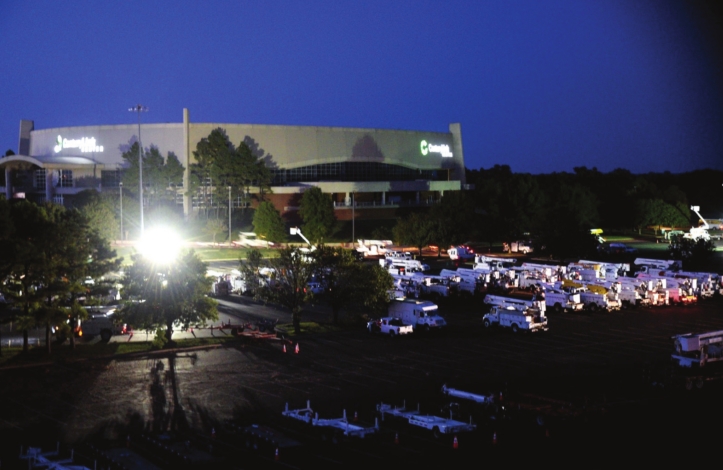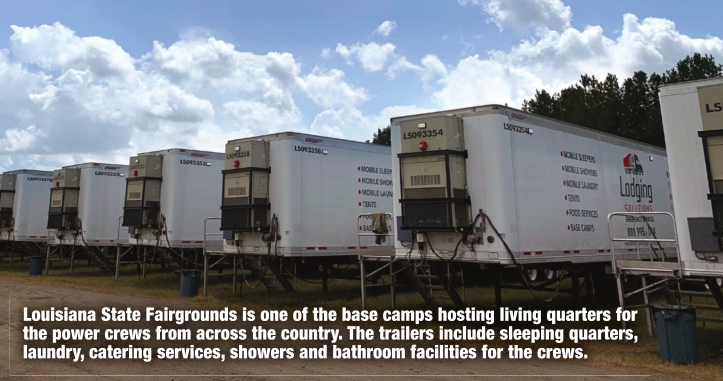SWEPCO Base Camps

Restoring power to Louisiana
An
army has invaded Louisiana. It came quickly, almost unnoticed, its
forces spread across the landscape; virtually nowhere is unaffected.
Their
base camps are easy to spot. Vast numbers of vehicles and materiel
sprawled across acres of real estate. Vehicles of all descriptions, some
wheeled, others tracked, mostly white, and all marked with the signs of
previous field exercise.
The personnel are easy to spot as well, hard hats and optic yellow vests, shod with boots that have seen many miles and all kinds of terrain and weather. They are seen marching through neighborhoods all over the state. Grim, serious combatants with a massive battle plan to execute: to get Louisiana back on the grid.
The men and women of this army are fighting an enemy who has come and gone, leaving devastation in her wake – Hurricane Laura. From the Gulf of Mexico to Arkansas, Laura pounded the power grid. Trees were ripped up by the roots and thrown across distribution lines. Limbs snapped from old-growth trees and were flung onto power lines. In a few hours on Aug. 27, life in Louisiana lost its electricity, and these soldiers were charged with reconnecting the Bayou State.
The task requires
an enormous amount of time, effort and organization. In normal times,
electric utility companies are used to dealing with the challenges. As
if a Category One hurricane in north Louisiana was not enough, mix in
COVID-19 and the plot thickens. Storms are a fact of life on our planet,
and utilities are prepared to respond quickly to getting power restored
to damaged areas. Michael Corbin is the external affairs manager for
SWEPCO (Southwestern Electric Power Company, a division of American
Energy Products.)
“We understand what to do in a storm. This storm was quite challenging because of COVID-19. We do everything we can to protect our workers.” In this case, the workers are not just local. “There are about 3,200 workers who have come here from across the U.S. and Canada. Right now, we are at 15 states plus Canada who have sent workers as part of our mutual aid agreement with other utilities,” Corbin explained.
He said when it became clear Laura had taken aim at Louisiana, the utility company began preparing to bring in the expected resources and personnel to restore the electric grid. They learned that most of the local hotels and inns were restricting their occupancy due to COVID. The state had also block reserved rooms in anticipation of evacuees from south Louisiana being displaced.
Corbin said they turned to a company with whom SWEPCO had worked before, Storm Services of Houston. Soon, the convoys began to roll, and even as Laura was passing through on Thursday, the base camps were set up, generators put in place and powered up. Three camps were set up. One at the State Fairgrounds in Shreveport, another at the Century Link Center in Bossier City and a third in Hornbeck, La. Corbin anticipated repairs would have progress sufficiently by the middle of last week to redeploy the workers from this
An
army has invaded Louisiana. It came quickly, almost unnoticed, its
forces spread across the landscape; virtually nowhere is unaffected.
Their base camps are easy to spot. Vast numbers of vehicles and materiel sprawled across acres of real estate. Vehicles of all descriptions, some wheeled, others tracked, mostly white, and all marked with the signs of previous field exercise.
The personnel are easy to spot as well, hard hats and optic yellow vests, shod with boots that have seen many miles and all kinds of terrain and weather. They are seen marching through neighborhoods all over the state. Grim, serious combatants with a massive battle plan to execute: to get Louisiana back on the grid.
The men and women of this army are fighting an enemy who has come and gone, leaving devastation in her wake – Hurricane Laura. From the Gulf of Mexico to Arkansas, Laura pounded the power grid. Trees were ripped up by the roots and thrown across distribution lines. Limbs snapped from old-growth trees and were flung onto power lines. In a few hours on Aug. 27, life in Louisiana lost its electricity, and these soldiers were charged with reconnecting the Bayou State.
The task requires
an enormous amount of time, effort and organization. In normal times,
electric utility companies are used to dealing with the challenges. As
if a Category One hurricane in north Louisiana was not enough, mix in
COVID-19 and the plot thickens. Storms are a fact of life on our planet,
and utilities are prepared to respond quickly to getting power restored
to damaged areas. Michael Corbin is the external affairs manager for
SWEPCO (Southwestern Electric Power Company, a division of American
Energy Products.)
“We understand what to do in a storm. This storm was quite challenging because of COVID-19. We do everything we can to protect our workers.” In this case, the workers are not just local. “There are about 3,200 workers who have come here from across the U.S. and Canada. Right now, we are at 15 states plus Canada who have sent workers as part of our mutual aid agreement with other utilities,” Corbin explained.
He said when it became clear Laura had taken aim at Louisiana, the utility company began preparing to bring in the expected resources and personnel to restore the electric grid. They learned that most of the local hotels and inns were restricting their occupancy due to COVID. The state had also block reserved rooms in anticipation of evacuees from south Louisiana being displaced.
Corbin said they turned to a company with whom SWEPCO had worked before, Storm Services of Houston. Soon, the convoys began to roll, and even as Laura was passing through on Thursday, the base camps were set up, generators put in place and powered up. Three camps were set up. One at the State Fairgrounds in Shreveport, another at the Century Link Center in Bossier City and a third in Hornbeck, La. Corbin anticipated repairs would have progress sufficiently by the middle of last week to redeploy the workers from this area farther south to assist in the massive clean up and repair facing those areas.
“We actually have two service areas,” he said. “We have the Shreveport service area, which is Shreveport, Bossier, Haughton, Plain Dealing, Benton, Vivian and that little corner of the state. Then, what we call the valley district is Stonewall, Natchitoches, all the way down to DeRidder, kind of hugging the Texas state line. They had far more damage than we had up here, just due to higher winds, and a lot of that is rural area, so a lot of tree damage and limb damage impacting our lines.”
He said there were additional complications in some areas of the state. While SWEPCO distributes the power in some rural areas, other utilities are responsible for generating power and distributing it to their customers. With all the damage in the state, some of those utilities are lagging in power restoration.
Early last week, Corbin said they anticipated almost 100 percent restoration in the Shreveport area within a week of the storm. Completion of the work was thanks to that army of troublemen, as they are called, who come from other utilities with whom SWEPCO shares a mutual aid agreement to assist each other when disaster strikes. The troublemen were housed at base camps in groups of about 1,000 in air-conditioned bunkhouses built onto 18-wheeler frames. The camps had showers, restroom facilities, catering services, vehicle service and repair facilities – all the comforts of home, even though it is anything but.
“By 5:30 or 6 o’clock, they’re eating breakfast and having their safety meetings, checking their vehicles out, getting assignments, and many of them before 7 o’clock are on the road to put in a 16-hour day,” according to Corbin.
Those days will continue for some time, he said, adding media reports that restoration in the Lake Charles area could take weeks or months are not hyperbole. He said he has seen pictures of a swath of perhaps 50 transmission poles neatly laid down on a five-lane roadway in Lake Charles. Transmission lines are the cables carried on the very tall aluminum towers seen around town and across the countryside. Corbin explained they carry high levels of energy from power stations to substations and between substations. When those are damaged, it requires a lot of effort to get them back in service; they can’t be recycled.
“You have to clean it up. You have to get new poles. No utility stocks hundreds of transmission poles. Wherever those poles are manufactured, they have to be built, put together to order, trucked in and then erected.”
The news is not all bad, however, when a storm blows through, Corbin said. “In a way, a storm like this helps us because those old poles that have begun to rot off in the ground are going to be the first to go away, and we can make improvements as we are rebuilding our grid.”
As frustrating as being without power after a storm is to residents, the headaches Mother Nature creates for public utilities are many times multiplied. But there is some comfort in knowing that an army of grim-faced troublemen soldiers are marching on those neighborhoods in the dark.


